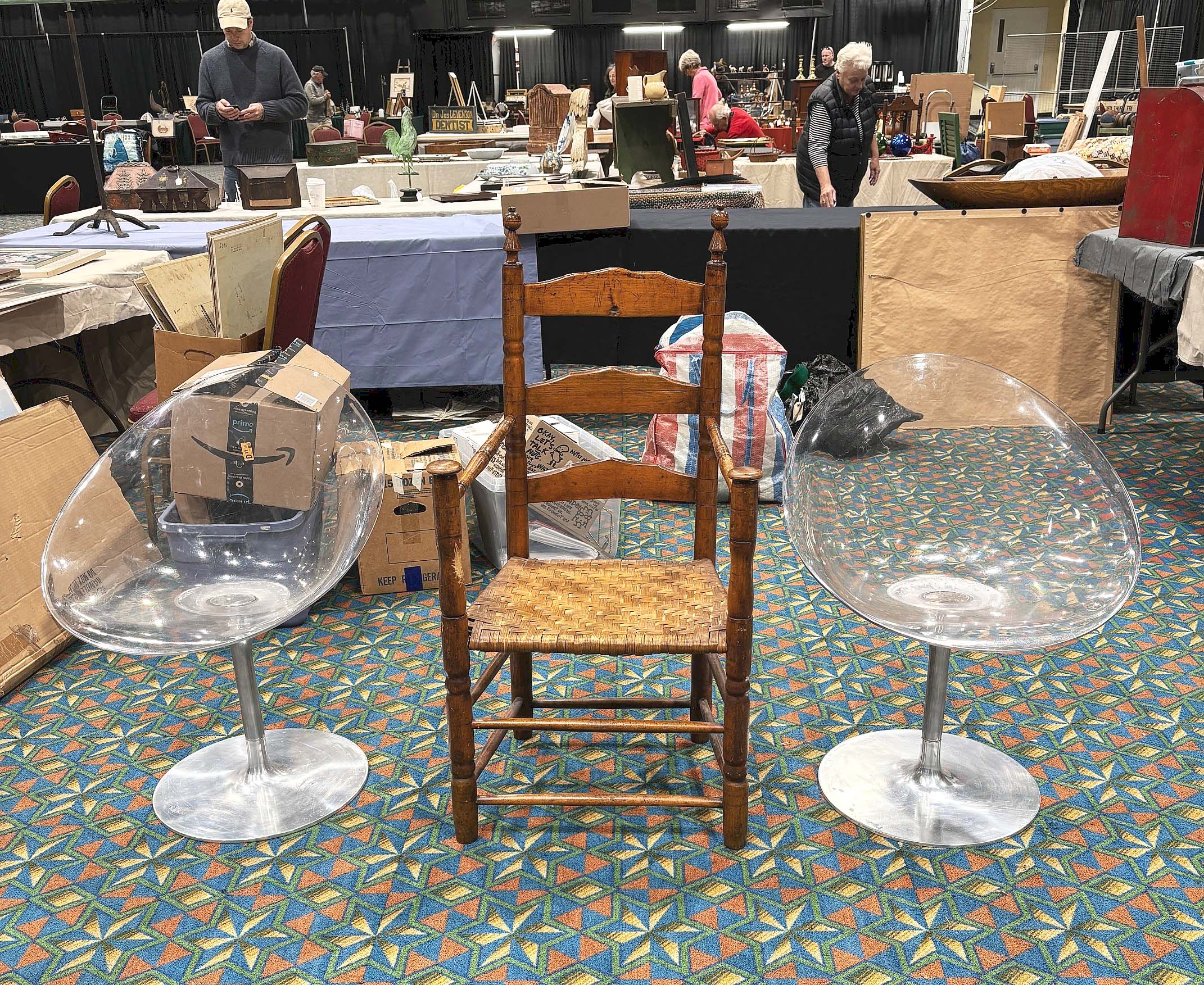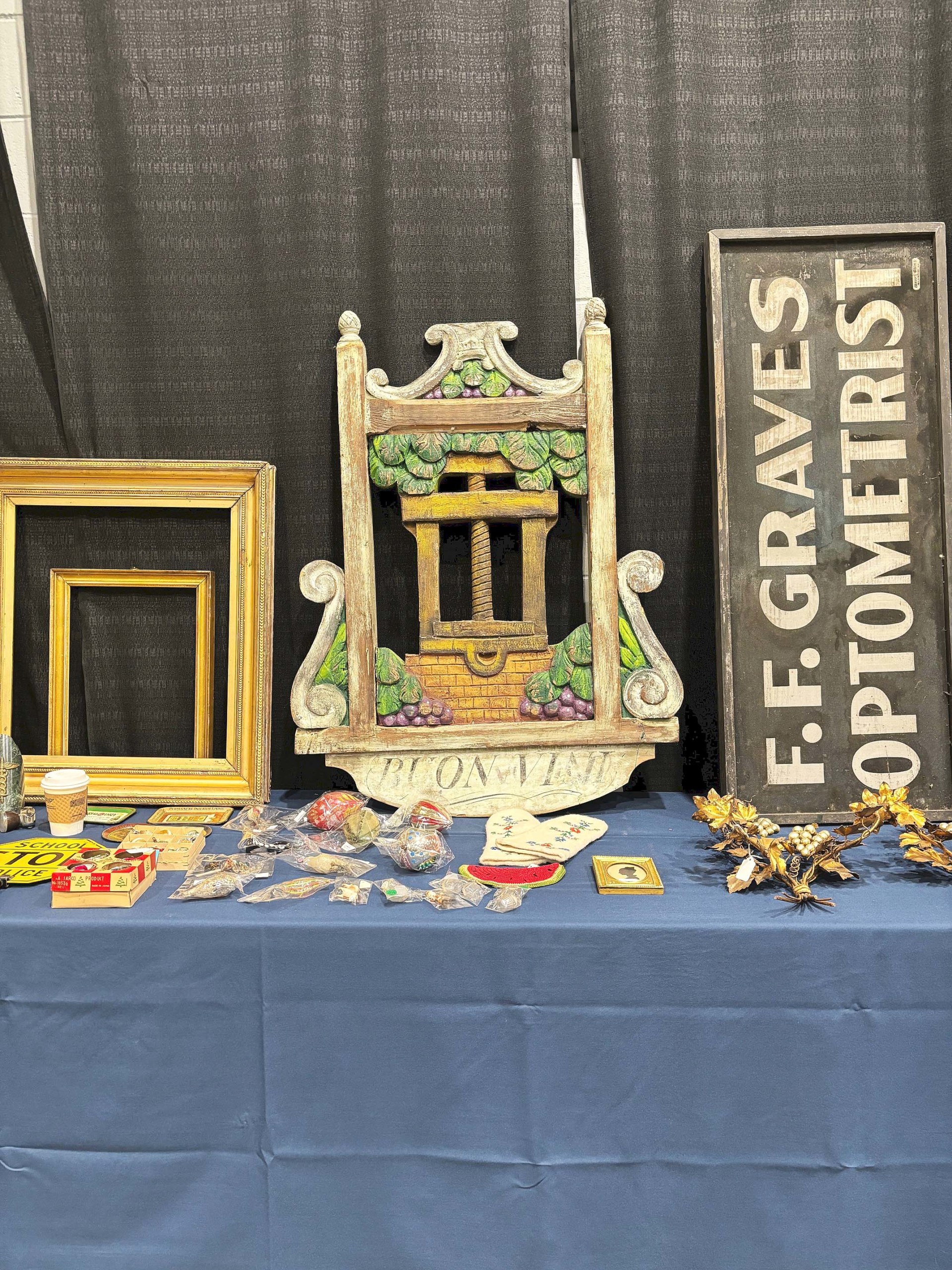
Wooden ware, early lighting, stoneware and more filled the large booth of Brett Cabral, Salem, N.H.
Review & Onsite Photos by Rick Russack
BOXBOROUGH, MASS. — Rachel and Josh Gurley got their fall and winter show season off to a good start on October 20, at the Boxboro Regency Hotel. They will host shows there in upcoming months in addition to shows they run in Bath, Maine; Dover, N.H.; and at the Royal Trade Center in Marlborough, Mass., on the Sunday of Thanksgiving weekend. There were 40 dealers in the season opener and the selection of merchandise offered leaned, as it always does, towards Americana. There were also dealers with Midcentury Modern material, Asian items, numerous paintings, ceramics, redware, stoneware, early glassware, historical documents, dolls and toys and textiles, as well as silver and jewelry. And, given the time of year, there was a plentiful selection of both Halloween and Christmas decorations and accessories. As we’ve come to expect at a Gurley show, quality was high and much of the merchandise was fresh to the market.
A couple of examples will give you an idea of the range of material offered. Furniture at the show covered a 300-year time span. Bert Rosenberg, Medfield, Mass., had a pair of molded polycarbonate chairs, made in the 1970s or 80s, with engraved labels noting “Ero(s) by Kartell with S+Arck, Made in Italy.” Philippe Starck (French b 1949) was a well-known Midcentury designer and architect. At the other extreme, Bill Graham, Haverhill, Mass., priced at $750 a carved English oak table dating back to perhaps as early as the Seventeenth Century and Brian Cullity, Sagamore, Mass., had a circa 1760-80 New England mahogany drop leaf table, which he priced at $800. This table included New York City dealer Israel Sack in its provenance.

Massachusetts dealer Bert Rosenberg set up three chairs in an interesting arrangement, flanking a mid Eighteenth Century Pilgrim century style chair with two circa 1970s-80s lucite chairs.
Stoneware also provided evidence of the range of material available. Several dealers had examples of Nineteenth Century cobalt-decorated jugs and crocks. Others, including Hollis Brodrick, Portsmouth, N.H., and Brian Cullity, Sagamore, Mass., had pieces of Westerwald stoneware jugs produced in Germany in the Seventeenth and Eighteenth Centuries.
Brodrick and Cullity, along with Oliver Garland (Falmouth, Mass), John Prunier (Warren, Mass.), John Hunt Marshall (Westhampton, Mass.) and others, also had early European ceramics. Cullity had several pieces of Dutch Delft, including a circa 1680 Wanli-style charger decorated with painted Oriental scenes, for which he was asking $1,350. Brodrick had a circa 1740 Astbury teapot, decorated with the English symbols of empire, including a unicorn and a crowned lion.
Trade signs and folk art abounded. Garland had a large, heavily carved and painted memorial piece depicting, among other things, a weeping willow; the price was $1,850. Deep River Antiques, Essex, Conn., showed a large carved and painted swan decoy listed at $150. It had been found in New York State, but nothing was known about the carver. Dennis Raleigh and Phyllis Sommer, Searsport, Maine, had a large tinsmith’s trade sign, probably used in a shop, in the form of a candlestick with a snuffer that was marked $1,250. Rachel and Josh Gurley had a large carved and painted trade sign that had probably come from a wine-merchant’s shop; they were asking $1,200. Jay Satin, Marblehead, Mass., had a large carved model of the 1882 monitor, USS Puritan, with swivel deck-mounted cannons, lifeboats and more, priced at $825. Marshall brought a selection of carved walking sticks.

Rachel and Josh Gurley’s booth had several trade signs, the most unusual of which was this carved and painted sign, probably from a wine seller’s shop. They thought it dated to the late Nineteenth or early Twentieth Century and were asking $1,200.
Several dealers offered selections of wooden ware. The Village Braider, Plymouth, Mass., had a very large burl bowl. Brett Cabral, Salem, N.H., had a large selection of lapped, or banded, canteens, firkins and covered boxes. He identified one of the canteens as English, from around the turn of the Nineteenth Century; it was tagged $495, while an Eighteenth Century American example was priced $525. One of Cabral’s large oval painted pantry boxes was priced at $495. He also had about half a dozen early “hogscraper” candle holders, which ranged in price from $150 for a slightly damaged one to $325 for one with “wedding band” decoration.
Country furniture included an exceptional primitive, early child’s high chair, which appeared to have been used by several generations of a family. It had a footrest, simply turned rod arms and a warm and mellow patina with remnants of old blue paint. It belonged to Barbara Rotundo, Country Collectible Antiques, Methuen, Mass., who was asking $325. Bill Graham had a lift-top blanket chest with its original red painted surface, for which he was asking $350.
Collectors of Native American beadwork and other artifacts would have found large selections throughout the show. Robert Bauver, New Salem, Mass., had several beaded artifacts, all well identified and labeled. One item was a large Eskimo or sub-artic sled bag, which he priced at $1,850. A circa 1890 pair of Southern Cheyenne beaded moccasins, with long fringe, was marked $3,200. He also had a Northern Plains pair of moccasins with parfleche soles, circa 1890, for which he was asking $1,850. A small selection of baskets, including a Louisiana twilled basket, which Bauver attributed to the Chitimacha culture; it was tagged $150. He also had an eye-catching silver Navajo headstall or bridle, priced $3,900. Jim LeFurgy and Judy Warner, Winthrop, Maine, had a large assortment of Eastern Woodlands beaded bags and pincushions. A beaded wall pouch was $110, their largest large pincushion, was decorated with beaded American flags and a beaded royal crown, which perhaps indicated a reference to Canada.

Jim LeFurgy and Judy Warner, Winthrop, Maine, can be counted on for a selection of Native American items. They had an assortment of Eastern Woodlands beaded items, including the large pin cushion (shown top center) decorated with an American flag and a crown.
Foot traffic was light but most of the dealers we spoke to after the show were pleased with the day. Perhaps Garland summed it up best, “I did pretty well, actually. It was a light crowd, but I ended up selling two good objects and a couple of smaller pieces. The buying was great. Customers and dealers who do not attend are missing out!” Brett Cabral added, “Customers continued to come throughout the show. The crowd was small but that seems to happen during presidential election seasons.” Bev Longacre said, “Our day turned out fine. Quite a few smalls sold as did a nice weathervane.” Dave and Jane Thompson commented, “We did quite well, as did some other dealers. The crowd did seem a bit light. The weather was beautiful, so maybe people were out apple picking or leaf peeping. Still, we were pleased that we sold a large painting and a historic railroad lithograph, some of our more expensive items, later in the show.”
Josh and Rachel Gurley have frequently said that they consider their exhibitors as family. They’ve known many since they were teenagers, helping at their mother’s shows. That’s true; this writer remembers them as porters doing Nan Gurley’s shows. They demonstrated this family attitude during the show, leaving the booth of the late Matt King, a regular exhibitor at Gurley shows, empty, draping it in black as a simple memorial to him.
After the show, Rachel Gurley commented, “I don’t know why our attendance was down. Maybe the gorgeous fall weather, maybe the presidential election, but the smaller than usual crowd didn’t have any effect on the selling. There weren’t any complaints from our dealers. We had four dealers who haven’t done the show before and they all signed up for the next one which will be January 5 and I feel really good about that. This show has a really good group of dealers — they know their stuff and they know the kind of stuff the crowd is looking for. It’s the perfect combination.”
For additional information, www.gurleyantiqueshows.com or 207-396-4255.





























